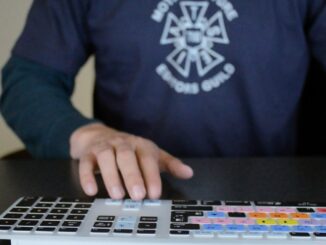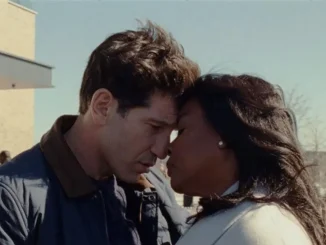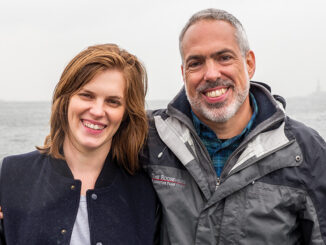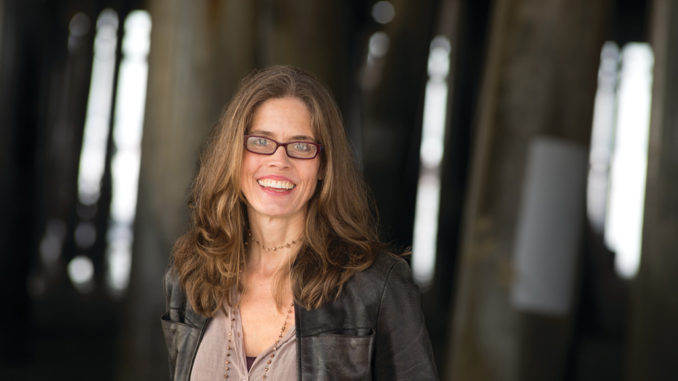
by Rob Feld • portraits by Martin Cohen
The way Plummy Tucker, ACE, caught the film bug was almost unfair. Out of Middlebury College and visiting the Delaware boarding school where she’d spent two years of high school, she heard that a movie was going to be shooting on campus that needed a location liaison. It sounded cool so she applied for the job and spent the shoot as a location PA, also working in other departments, as Peter Weir directed Robin Williams in Dead Poets Society. “It was a magical thing,” the editor says. “The Teamsters would tell me, ‘Don’t get into the movie business because of this one, kid. It’s never like this.’”But the dice were loaded and she was hooked.
The film’s location manager, Michael Meehan, gave her sage advice about the departmentalized nature of the film business. “He told me, ‘You should really look at the jobs at the top of each track, see where you want to end up and get on that track,’” she recalls. “I’d been an English major and done a lot of creative writing and theatre, and I wanted to be involved in telling stories.” Writing, directing and editing interested her, but she didn’t know a thing about filmmaking. “Editing has an apprenticeship path where you can learn about filmmaking,” she explains, “so when people asked, I’d say I was interested in editing — even though I didn’t really know what it was.”
Tucker worked her Dead Poets relationships in LA to get internships in editing rooms, eventually working for Nancy Richardson, ACE, who became a mentor, and finding her way back to New York as a Guild apprentice on Weir’s Green Card under William Anderson. After working for years as John Sayles’ assistant and then additional editor, Tucker was asked by Sayles’ former assistant, Karyn Kusama, to edit her first feature, 2000’s Girlfight.
Tucker has edited all of Kusama’s films since, the latest being The Invitation, set to premiere at SXSW in March, with a distributor and general release date undetermined at press time. It’s a creepy story about a once-loving husband and wife, the latter of whom disappears after the loss of their son — only to return years later as an eerily changed person with a different husband.
In addition, Tucker recently finished work on the premiere episode of the NBC miniseries The Slap, directed by Lisa Cholodenko, which premieres February 12. It is based on the novel and an Australian TV series of the same name, and concerns what happens to a group of old friends when one of its members slaps the misbehaving child of another couple at a party.Her credits also include episodes of the TV series The Red Road and Power, and Alex Gibney’s documentary, Client 9: The Rise and Fall of Eliot Spitzer.“Like Mike Meehan said to me back in the day, not only is the business departmentalized once you get on the track, but once you cut a romantic comedy that makes money, all anyone wants you to do is cut a romantic comedy,” Tucker says. “So I keep trying to jump around.” Between jumps, Tucker found the time to talk to CineMontage about her varied career, including her upcoming projects.
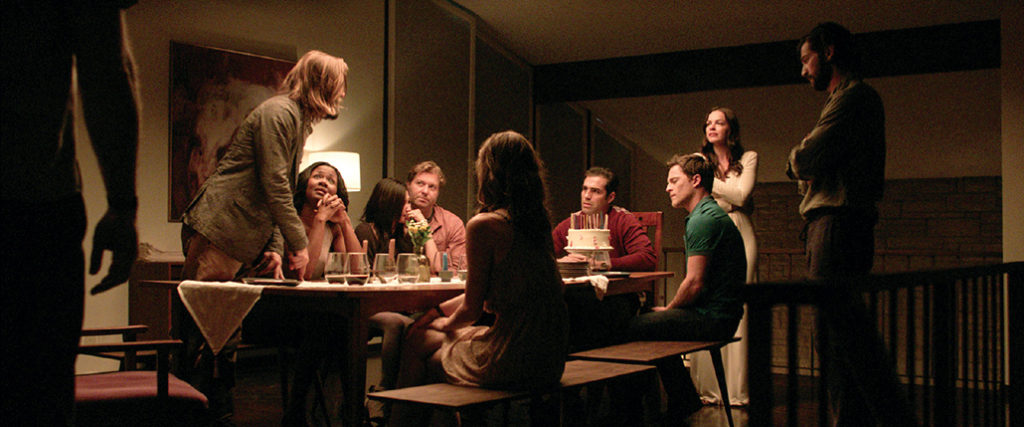
CineMontage: Your path took you through some great experiences. What were some of the lessons learned from those apprenticeship moments?
Plummy Tucker: I worked for many years with John Sayles. He is such an amazing storyteller; I learned so much about story structure, on the script level, from him. Working with him really was a family filmmaking situation. Cutting in his garage in the middle of nowhere, we’d editall day and hang around at night and have dinner. It was a great intersection of work and life. I wish more experiences could be like that.
As far as learning about editing per se, after Green Card, I went on to be assistant editor on Peter Weir’s Fearless, again with editor Bill Anderson. Bill is such a good editor; he cut on a KEM and we’d go through the dailies to organize the material, which was a wonderful way to learn. I still have my assistants prepare my dailies notes the way he had us do it for him: scene, take, short description, camera, sound roll, date shot info. Then I make quick, first-impression notes while screening. In that day and age, it was nice because you would screen dailies with the director. That almost never happens now, which is too bad. At the end of the day, even though everyone was tired, the editor, director, DP and other department heads would be together watching the footage.
Bill would have his notes and sit with Peter, who would explain what he was trying to do. You would get so much information. Then, if something looked weird — say, there’s a makeup issue or something — everything would get solved quickly because everyone saw it together. Now, everyone’s watching it in her or his own space in the hotel, or wherever. It’s funny because while somehow that’s more efficient, in other ways it’s less. There’s a kind of camaraderie that used to be that doesn’t seem to happen now.
“What I try to do on any film is talk to the directors about anything that might be a creative reference for them: other films, art, music, events, anything they’ve been referencing creatively. I take notes and keep coming back to it when I’m cutting.” – Plummy Tucker
CM: How did you work with Anderson?
PT: When Bill sat down to cut the scene, he would mark ins and outs with a grease pencil for the pieces he liked, and then I’d take the rolls and pull those pieces, grouping them in wides, mediums and tights for each performance. You would see and hear his process because you’d be assembling it; I’d see what he had chosen and what he hadn’t because I was at dailies. It was such a lesson in what’s important. That was a huge thing for me. Another was seeing different screenings: editor’s cut, director’s cut, etc. You see how it’s honed and refined.
CM: How did you make the leap from assistant to full editor?
PT: Because I did all those films with John Sayles, I kept assisting longer than I might have. He cuts his own films and loves doing it. But he would give me a few scenes to cut, really for my own development, so I was an additional editor for a while. In between, I would cut smaller stuff like an NYU grad film or a documentary. Then John helped Karyn Kusama get Girlfight going and she asked me to cut it.
CM: You’ve done four films with her now. What working process have you two developed?
PT: I’ve always been on location with Karyn. She will often call me on her way to or from the set and give me a redux of the previous day. Or we’ll get together on the weekend to talk through what she was trying to do with something, especially if it’s not self-evident in the footage. I find it incredibly useful. This means I can get closer in my first pass to what was she was going for. We have a similar sensibility, or perhaps I’ve learned her sensibility.
Karyn likes to be spend time in the cutting room. I’ve worked with directors who are there all the time, and others who are never there, and there’s value to both. Now that we’ve done so many films together, though, she’s able to step back a little more, which I think is good for her process. It’s nice if the director has a bit more perspective, and can go off and come back while you’re trying this and that. But it starts with what she does; she’s great with actors and very hands-on with design and cinematography.
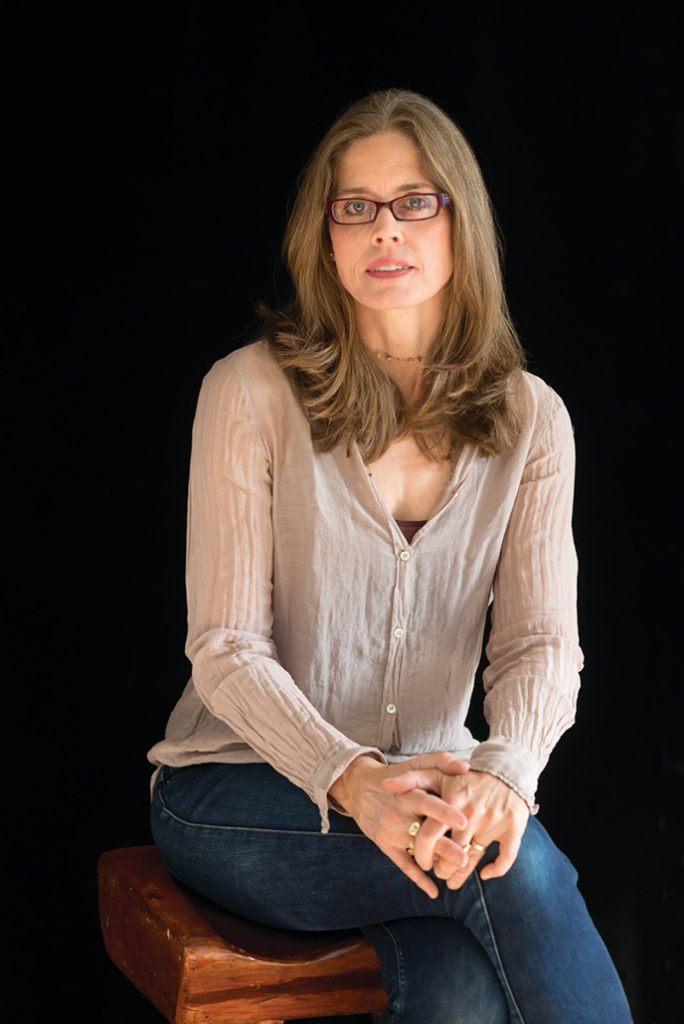
Once the footage comes to me, it’s just a process of getting to the heart of the character with her. What I try to do on any film is talk to the directors about anything that might be a creative reference for them: other films, art, music, events, anything they’ve been referencing creatively. I take notes and keep coming back to it when I’m cutting. If there are references to films or music they like, I immerse myself in the feeling they’re going for.
PT: For The Invitation, Karyn talked about Klute and The Parallax View with regard to shooting and sound design style, The Conformist and Red Desert for an approach to color and design, Safe for a tonal approach, Throne of Blood for an approach to score, High and Low for and approach to blocking in a confined space, The Celebration for a depiction of a dinner party gone haywire, and Let the Right One In and Rosemary’s Baby for an approach to violence — mostly unseen. These were the films that were floating in and out of her consciousness as she prepared for The Invitation, so they became a jumping off point for me in the editing process.
CM: What was it like working on The Invitation and The Slap back-to-back?
PT: It was interesting; they had similar challenges to be addressed. They are both about lots of people at a gathering, with overlapping narratives, but were told in two completely different shooting styles. Karyn’s route was more Kurosawa — formal frames — and Lisa’s was more Altman — multiple moving cameras. In both cases, post-production sound played a huge role in keeping the audience engaged in the story, hearing people in other rooms, and the comings and goings. Both projects had shorter schedules and less prep than either director would have liked. And both used multiple cameras to maximize what they could get on a limited schedule.
CM: What about the differences?
PT: Due to the shooting style on The Invitation, it was much easier to see, upon viewing dailies, where I might be lacking in coverage and let Karyn know. Some days, she would give me a heads-up to pay particular attention to a scene she had just shot, if she was concerned they hadn’t had time to get all the shots she wanted, so that I could let her know if I could cut it with what she had gotten.
The Slap was much more complicated, with more footage and often a third camera. There were a lot of good performances, but it was nearly impossible to tell if I had what I needed without watching every single frame, as the cameras often covered different things in different takes. I had to take copious notes during dailies and make string-outs of what exactly I had on particular beats. It was a little hair-raising getting to my editor’s cut — very rewarding ultimately, but I had to clock a lot of hours to get there!
CM: Generally, how does editing for TV differ from editing for features?
PT: It’s just huge. They frequently don’t hire feature editors for TV because they think the schedules are so fast that if you’re used to a long schedule, you won’t be able to do it. There’s a whole part of the process that happens in features that doesn’t happen in TV because of the schedule. It’s not that you have to put it together faster than a feature; editors always have to put their cuts together quickly. It’s that you don’t have the same time to finesse. For an hour of TV, you get a day for your editor’s cut, whereas for a movie — generally twice as long — you typically get a week.
The main thing that I value from having done. TV now is that you just can’t be precious; you have to whack it together, and that can be kind of great. Unfortunately, you don’t have a lot of time for one of the parts of the process I most love in editing: the honing. In TV, you don’t get that chance unless the executive producers and network want to try different things. With a feature, there is usually time — or somebody wants to investigate another avenue. With television, you have to pick a way and do it. That’s why oftentimes TV episodes are shot the way they are; really efficient TV directors will shoot it to be cut a certain way because they know the time for re-cutting is limited. If they want to have an impact, they want their vision to be clear in the shots they’re giving you.
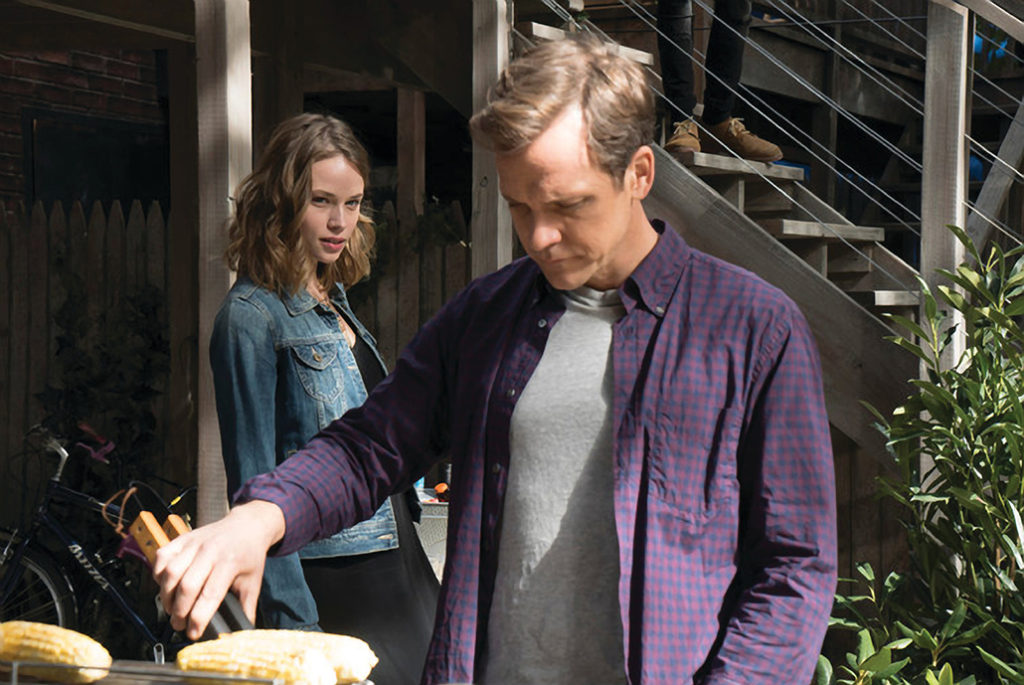
CM: How does that relate to your experience onThe Slap?
PT: The Slap is a miniseries and we had a lot more time for the first episode than you would normally, so we were able to investigate some things. We also had a lot more footage than we would have had on a regular episode. I think what we did there is something in between a TV show and a feature.
It was the first episode; they were still writing, running and gunning on set, and shooting with multiple cameras at all times. In television, in my limited experience thus far, they tend to shoot with two cameras, but on this show it was often three. It was a bit of a mind-bender for me because of the sheer volume of material and the time I had to put it together. But I’m really happy with how the episode turned out.
CM: Do you think about the difference between big and small screen when you’re editing, or has that just become irrelevant these days?
PT: I do, but it’s weird because there is a lot of stuff you would think wouldn’t fly, but it will because it’s not going to be on a 40-foot screen. Things also tend to play in a different speed on thebig screen, which is always something I think about on features. When I’m cutting TV, I tend to make it play for what I’m watching it on. I’ll sit back and watch it on the 42-inch screen because that’s what a lot of people have now.
People are going to watch The Hobbit on their phones, so I don’t know what to do anymore, even for features. Yes, you can make it for the big screen, but then certain things will just be lost if you’re going to watch it on a phone…which is an understatement.



